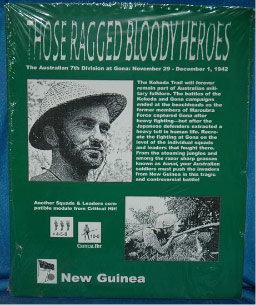Westy
Member
Just got back from Kokoda track - 8 day trek. Amazing experience and simply incredible terrain. Have enough material for at least 20 scenarios. Curious as to what level of interest there might be.
Give us pictures or it didn't happen...Just got back from Kokoda track - 8 day trek. Amazing experience and simply incredible terrain. Have enough material for at least 20 scenarios. Curious as to what level of interest there might be.
Me too, bring it on, I want to get a Kokoda Trail series of scenarios into Dispatches, just published the first one but was not sure what to look at next there, if you come up with some and have no other outlet, please contact me at aslbunker@aol.com I am VERY Interested! Vic.Just got back from Kokoda track - 8 day trek. Amazing experience and simply incredible terrain. Have enough material for at least 20 scenarios. Curious as to what level of interest there might be.
More PTO is always welcome!Just got back from Kokoda track - 8 day trek. Amazing experience and simply incredible terrain. Have enough material for at least 20 scenarios. Curious as to what level of interest there might be.
My thoughts exactlyMore PTO is always welcome!

Those Ragged Bloody Heroes (Gona HASL) was released in the 1990s via Critical Hit, but it has not had much love (as far as ROAR is concerned anyway).The entire Kokoda, Gona-Buna Campaign is quite interesting and very underrepresented both historically and in ASL. Taken in total it lasted longer and began earlier than the Guadalcanal operation as well as incorporating a greater number of combatants from all sides involved along with the resultant greater degree of casualties involved. The number of Battle casualties (KIA, WIA & MIA) by suffered by the Australians and Americans was three times greater than those suffered by the Marines and US Army units on The Canal. By comparison, the USMC units on Guadalcanal suffered approximately one battle casualty for every 34 men whereas the in the Kokoda, Gona-Buna Operation the ratio was one out of every 11 men committed, the majority being suffered among the Australians at about a 3:2 ratio. This may be because of the general strategic/operational nature of the struggles; the Australians and Americans at Kokoda, Gona-Buna were generally conducting an offensive operation whereas the marines on the canal were generally in a defensive posture. Of course, if one takes into account the non-battle casualties form Malaria, dysentery, jungle-rot, etc., the ratios were quite similar. One Australian company was able to muster only a single soldier as declared battle worthy after the fight for Gona, and he had a temperature of 101 degrees and wasn't suffering from a malaria bout at the time. My dad's company fared a bit better after Buna, being able to muster three battle worthy men (my dad wasn't one of them).

Hi Joe, The trek has inspired me to read heaps of books and unit histories on the topic. And I took lots of photos of the terrain. I simply can believe the Japanese attacked up Mission ridge. It would be a quadruple ridge line…..at least!Just about finished "The Battle of Kokada Plateau" by David W. Cameron. It deals with the early battles on the Kokoda Track soon after the Japanese landings. The book has a lot of details, lots of first-person accounts and the early clashes for Kokoda village are described in details, sometime down to platoon/section level for both sides. You really get a feel for how terrible the conditions and the terrain was. I recommend it if you are looking to design a scenario featuring the early clashes.
I will. Let me know if anyone is interested in playtesting.Kokoda is a very interesting campaign.
I day go for it.
Thanks Vic….will get into it soon. What surprised me is the number of Aussie counter-attack situations when the aussies at a strategic level were conducting a delaying action.Me too, bring it on, I want to get a Kokoda Trail series of scenarios into Dispatches, just published the first one but was not sure what to look at next there, if you come up with some and have no other outlet, please contact me at aslbunker@aol.com I am VERY Interested! Vic.
